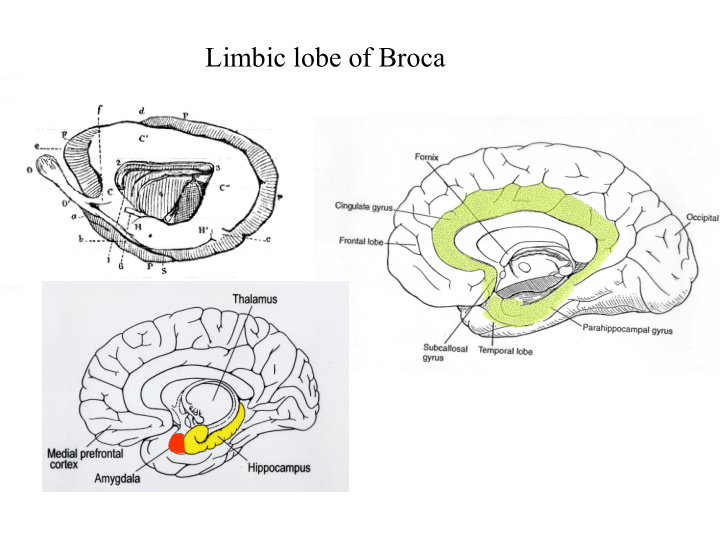



Limbic lobe of Broca
Olfactory inputs rabbit
Papez’s circuit Cingulate cortex Septal nuclei Fornix (basal forebrain) Thalamus * Mammillary bodies Hippocampus (hypothalamus) James Papez
Brain Stimulation during Surgery Wilder Penfield
Kluver-Bucy Lesion
Kluver-Bucy Syndrome following bilateral temporal lobectomy in monkeys. Main components are: visual defects, oral tendencies, and changes in emotional behaviour (hypersexuality, hypo-emotionality)
Papez’s circuit Cingulate cortex Septal nuclei Fornix (basal forebrain) Thalamus * Mammillary bodies Hippocampus (hypothalamus)
Henry Molaison 1926-2008 Suzanne Corkin Brenda Milner “… He … cannot recall anything that relied on personal experience, such as a specific Christmas gift this father had given him. He retained only the gist of personally experienced events, plain facts but no recollection of specific episodes .” Corkin, p 219
O’Keefe & Dostrovsky 1971
Place Cells Typically, cells are recorded while a rat moves around foraging in a box (arena). A given cell only fires when the rat is in a particular part of the arena ( the place field)
Spatial cells in the hippocampal formation Place cells Grid Cells Head Direction Cells
SPACE Existence of hippocampal signals plays a role in all our behaviour. coding direction, distance and speed of movement We live in it, move through it, explore it, defend it. Deficits in place learning, navigation, We find it easy enough to point to bits of it: and exploration the room, the mantle of the heavens, the gap between two fingers, the place left behind when the piano www.cognitivemap.net finally gets moved. O’Keefe & Nadel 1978
Papez’s circuit Cingulate cortex Septal nuclei Fornix (basal forebrain) Thalamus * Mammillary bodies Hippocampus (hypothalamus)
By stimulating the hypothalamus, he could induce behaviors from excitement to apathy; depending on the region of stimulation. He found that he could induce different types of responses when stimulating the anterior (lateral) hypothalamus compared to stimulating the posterior ventromedial hypothalamus. When stimulating the anterior part, W R Hess he could induce fall of blood pressure, slowing of respiration and responses such as hunger, thirst, micturition (urination) and defecation. On the other hand, stimulation of the posterior part led to extreme excitement and defense-like behavior. [3] Hess also found that he could induce sleep in cats — a finding that was highly controversial at the time.
R Descartes
Kuo, Z. Y. (1930). The genesis of the cat's responses to the rat. Journal of Comparative Psychology, 11 (1), 1-36. Specifically, the author sought to determine the effects of the following conditions on the behavior of the cat toward the rat, including under the term rat wild mice, albino rats, and wild rats: (1) raising kittens in isolation, (2) raising kittens in a rat-killing environment, (3) raising kittens in the same cage with rats, (4) difference in food-habit, i.e., vegetarianism versus non-vegetarianism, (5) difference in hunger condition, (6) use of reinforcing stimuli such as seeing another cat kill a rat, (7) use of different kinds of rats, and (8) training by the conditioned response method that would make the cat fear the rat. Results included the following: (1) of the kittens raised in isolation, 54% killed rats without the so-called learning; (2) of the kittens raised in a rat-killing environment 85% killed rats before the age of four months, always the kind of rat they had seen their mothers kill, and some killed other kinds as well; (3) of the kittens raised with rats as cagemates none killed other kinds; (4) vegetarianism had no effect on rat-killing but did affect rat-eating; (5) hunger conditions appeared to have no effect either on rat-killing or rat-eating; and (6) not all the cats used learned to fear the rat, i.e., to run away from the rat. The author believes that the organismic pattern (by which he does not mean neural pattern) or bodily make-up is sufficient to explain why a cat behaves like a cat, i.e., why it possesses certain behavior patterns that are usually known as instinctive. He is completely opposed to explanations of behavior in instinctive terms.
J P Flynn
D Pfaff
POSITIVE REINFORCEMENT PRODUCED BY ELECTRICAL STIMULATION OF SEPTAL AREA AND OTHER REGIONS OF RAT BRAIN James Olds and Peter Milner McGill University 1954
Recommend
More recommend